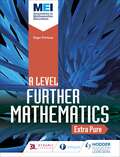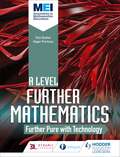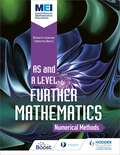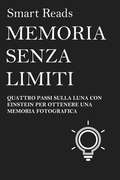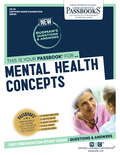- Table View
- List View
MEI Further Maths: Extra Pure Maths
by David BedfordDevelop a deeper understanding of mathematical concepts and their applications with new and updated editions from our bestselling series.- Build connections between topics using real-world contexts that develop mathematical modelling skills, thus providing your students with a fuller and more coherent understanding of mathematical concepts.- Develop fluency in problem-solving, proof and modelling with plenty of questions and well-structured exercises.- Overcome misconceptions and develop mathematical insight with annotated worked examples.- Enhance understanding and map your progress with graduated exercises that support you at every stage of your learning.
MEI Further Maths: Further Pure Maths with Technology
by Tom ButtonDevelop a deeper understanding of mathematical concepts and their applications with new and updated editions from our bestselling series.- Build connections between topics using real-world contexts that develop mathematical modelling skills, thus providing your students with a fuller and more coherent understanding of mathematical concepts.- Develop fluency in problem-solving, proof and modelling with plenty of questions and well-structured exercises.- Overcome misconceptions and develop mathematical insight with annotated worked examples.- Enhance understanding and map your progress with graduated exercises that support you at every stage of your learning.
MEI Further Maths: Numerical Methods
by Richard LissamanDevelop a deeper understanding of mathematical concepts and their applications with new and updated editions from our bestselling series.- Build connections between topics using real-world contexts that develop mathematical modelling skills, thus providing your students with a fuller and more coherent understanding of mathematical concepts.- Develop fluency in problem-solving, proof and modelling with plenty of questions and well-structured exercises.- Overcome misconceptions and develop mathematical insight with annotated worked examples.- Enhance understanding and map your progress with graduated exercises that support you at every stage of your learning.
MEMORIA SENZA LIMITI - QUATTRO PASSI SULLA LUNA CON EINSTEIN PER OTTENERE UNA MEMORIA FOTOGRAFICA
by Anna Spertini Smart ReadsMemoria senza limiti Quattro passi sulla luna con Einstein per ottenere una memoria fotografica
MENTAL HEALTH CONCEPTS: Passbooks Study Guide (Certified Nurse Examination Series)
by National Learning CorporationThe Certified Nurse Examination Series prepares individuals for licensing and certification conducted by the American Nurses Credentialing Center (ANCC), the National Certification Corporation (NCC), the National League for Nursing (NLN), and other organizations. The Mental Health Concepts Passbook® provides a series of informational texts as well as hundreds of questions and answers in the areas that will likely be covered on your upcoming exam.
MHD-16 Bhartiya Upanyas Vivechana - IGNOU
by IgnouEleven articles have been compiled in this curriculum. Development and expansion of the Indian novel in these articles have been seriously discussed. This book will help students to study novels.
MHD-4 Gaddhaya Sahitaya ki anya Vidhayain-II - IGNOU
by IgnouThis book written for MA hIndi course has section an autobiography, author mainpoints and its importance.
MHD-4 Hindi Natak aur Rangmanch-I - IGNOU
by IgnouIn this section the students gets the information about the times of Bhartendu till the current times. It also studies play and theatre of hindi.
MHD-4 Natak aur anya Gaddhaya Vidhayain (2) - IGNOU
by IgnouIt has drama's process and play's one is Mohan Rakesh and Dharam Veer Bharti has to be read.
MHD-4 Natak aur anya Gaddhaya Vidhayain (4) - IGNOU
by IgnouIn this book reader will read about plays and other more process.
MHD-4 Natak aur anya Gaddhaya Vidhayain (6) - IGNOU
by IgnouThis book gives precise discription of Bavelggne, memories and interview techniqnis in hindi literature.
MHD-4 Natak aur anya Gaddhaya Vidhayain - 3 - IGNOU
by IgnouIn this book of M.A. hindi there is play and process in its third section. In this section you will study about some other process.
MHD-5 Ras-Chintan ke Vividh Aayam - IGNOU
by IgnouIt reflects the various dimensions of pleasure - theory has been discussed in detail. pleasure in place of contemplation is the most important element of literature . In this contemplation the subtle movements of the human mind experiences the wonderful mix of emotions and knowledge.
MHD01 Aadi Kavya - IGNOU
by IgnouThe M.A. It is the first course of Hindi has four sections. Etc. Poetry, devotion Kawy- (poetic attributes), Bhakti Kawy- (Sagun poetry) and poetry Sagun. The first section is the unit in which four of Adikawy Prithviraj Raso composed poetry and fiction seen in the eyes of Chandbrdai vidyapati describes compositions.
MHD01 Bhakti Kavya - IGNOU
by IgnouThis is the second volume of devotional poetry. Sagun Bhakti poetry and poetic prose in which the attributes of the two sections. Section two of the main attributes in this section Bhakti poet Kabir's poetry and writings describe Jaycee. Jaycee in this verse of poetry and his work has been described Pdmawat special.
MHD01 Bhakti Kavya-2 - IGNOU
by IgnouSection three of the attributes in this section Baktikawy creators - Tulsi, Mira and Soor - is described. Which is four units. Surdas in devotion to Krishna, Meera describes the devotion and love to krishna of his poetry have been analyzed and Tulsidas. In this poetic description Tulsi described the Chanda by the Ramcharitmanas.
MHD01 Hindi Kavya Vivechana - IGNOU
by IgnouIn this book described about major poems which are written in Aadikal, Bhaktikal and Ritikal. In this section study. Prithviraj Raso and covers the time and vidyapati phraseology
MHD01 Reeti Kavya - IGNOU
by IgnouThe creators of the three major poetic manner in this section - describes compositions of Bhihari, Gnanand and Padmakar. It has three units which are described in poems. Bihari's poetry, the poetry and Padmakar Gnanand poetry. Sringara the poetry and mystery Actor- Actoress is described in detail. This section describes the characteristics of Ritikawy.
MHD09 Bhartiya Sahitya mein Kahani - IGNOU
by IgnouIndia has had a long tradition of story telling. Vrihadhkatha, jatakkathayein and panchtantra come under the tradition of story telling in India there is a lot of material given on Indian renaissance story telling grew in leps and bounds during independence movement redus will also get to now how stories grew after India's independence.
MHD09 Hindi Sahitya ki Kahani - IGNOU
by IgnouIn this book story nature and development are discussed. This section has been studying the development of Hindi story. In this units involved in the content, its aim is to introduce Hindi story development.
MHD09 Kahani ke Siddhant aur Swaroop - IGNOU
by IgnouIn this book story nature and development are discussed. In this cerriculum, students study the different forms of narrative and narrative story as well as the meaning and nature of the study.
MHD09 Vishva Sahitya mein kahani - IGNOU
by IgnouThis is the third part of story curriculum, story format and story development. This sections tells us about the global perspective of the stories. The four sections of the books talks about story in Asia, Latin America, Africa and Europe. It also discusses about the development of stories in different countries.
MHD1 Hindi Kavya-1 - IGNOU
by IgnouIn this book described about major poems which are written in Aadikal, Bhaktikal and Ritikal. In this section study. Prithviraj Raso and covers the time and vidyapati phraseology.
MHD13 Bhartiya Sahitya mein Upanyas - IGNOU
by IgnouIn this book it is described about the national movement and Indian novel. In this section and discussed about writting in different languages about the major novels and novelists.
MHD13 Hindi Sahitya mein Upanyas - IGNOU
by IgnouThe book presents the rise and development of Hindi novel in Hindi literature and studying the development of criticism, the national liberation movement and Hindi fiction novel.
